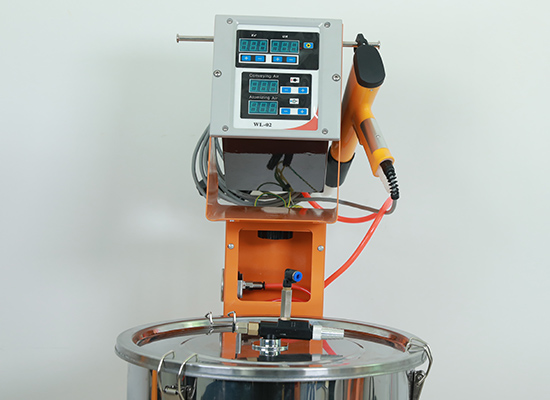Powder Coating Machine is the cornerstone of achieving remarkable coating results in diverse industrial and DIY projects. As a seasoned industrial expert put it, "Our powder coating machine has consistently delivered top-notch finishes, significantly enhancing our product quality and competitiveness." A passionate DIY enthusiast also shared, "My powder coating machine has opened up a new world of creativity, allowing me to transform ordinary items into extraordinary masterpieces with ease."

A
Powder Coating Machine comprises several vital components. The powder coating gun is the core, featuring an ergonomic handle for comfortable operation during extended use. It has a precise powder flow control mechanism, enabling users to regulate the powder output accurately. The nozzle atomizes the powder particles for even spraying. In electrostatic powder coating machines, the electrostatic charging system imparts an electric charge to the powder, enhancing its adhesion to the workpiece. The powder feeder stores and supplies powder to the gun at a steady rate. Additionally, some advanced machines come with a powder reclaim system, which uses filters or cyclones to collect and recycle oversprayed powder, minimizing waste.
Powder coating machines find extensive applications across various industries. In the automotive sector, they coat car bodies, wheels, and engine parts, providing a smooth, durable, and corrosion-resistant finish. The furniture industry utilizes these machines to coat metal frames and components, enhancing both the aesthetic appeal and longevity of the products. In the electronics industry, powder coating machines are employed to coat metal enclosures of devices, protecting them from environmental factors and electromagnetic interference. Small-scale workshops and DIY hobbyists use powder coating machines for custom coating projects on items like metal crafts, tools, and small automotive parts.
The cost of a
Powder Coating Machine varies based on its features and quality. Basic manual powder coating machines, suitable for occasional DIY use or small-scale projects, are priced between $100 and $500. These machines typically have simple functions and a basic powder feeder. Mid-range machines with electrostatic charging capabilities and better build quality range from $500 to $2000. High-end professional-grade powder coating machines, equipped with advanced features such as precise powder flow control, multiple spray patterns, and efficient powder reclaim systems, can cost over $2000.
Before operating the
Powder Coating Machine, ensure all components are properly assembled and grounded. Fill the powder feeder with the appropriate powder, taking care to avoid contamination. Adjust the powder flow rate and, if applicable, the electrostatic charge settings according to the workpiece and powder type. Hold the powder coating gun at a consistent distance, around 15-20 cm from the workpiece, and move it in a smooth, even motion while spraying. After use, clean the powder coating gun and powder feeder thoroughly to prevent powder buildup.
When selecting a
Powder Coating Machine, consider your specific requirements. For high-volume production or professional applications, choose a machine with advanced features and high durability. Beginners or those with occasional small projects may opt for a basic model. Evaluate the type of workpieces you'll be coating; complex shapes may require a machine with adjustable spray patterns. Also, consider the reputation of the manufacturer and the availability of after-sales support.
Wear appropriate personal protective equipment, including a dust mask, safety goggles, and gloves, to protect against powder inhalation and potential splashes. Ensure the work area is well-ventilated to prevent the accumulation of powder particles. Keep the machine away from flammable materials, as powder can be combustible. Regularly inspect the machine for any signs of damage or malfunction.
The design of a
Powder Coating Machine is rational and efficient. The electrostatic charging system in some models improves powder adhesion, reducing powder waste and ensuring a better finish. The adjustable powder flow rate and spray patterns offer flexibility for different workpieces, enhancing the overall coating efficiency. The inclusion of a powder reclaim system in advanced machines not only saves costs but also contributes to environmental sustainability.
Q: What should I do if the powder coating is uneven when using the
Powder Coating Machine?
A: Check and adjust the powder flow rate. Ensure the gun is held at a consistent distance and angle from the workpiece. If using an electrostatic model, verify the electrostatic charge settings. Also, check the air pressure for proper powder atomization.
Q: Can I use different powder types with the same Powder Coating Machine?
A: Yes, but it's essential to clean the machine thoroughly between different powder types to avoid contamination, which could affect the coating quality. Different powders may require different settings, so adjust accordingly.
Q: How often should I clean my Powder Coating Machine?
A: Clean the machine after each use to prevent powder buildup, which can affect its performance. For a more in-depth cleaning, disassemble the powder coating gun and powder feeder periodically and clean each component.
Q: What if the powder doesn't flow properly from the Powder Coating Machine?
A: Check the powder feeder for blockages and ensure the powder flow control mechanism is working correctly. Also, make sure the powder is not too moist or compacted, as this can impede the flow.
Q: Can I upgrade the features of my Powder Coating Machine?
A: In some cases, it may be possible to upgrade certain features, such as adding an electrostatic charging system or replacing the powder coating gun. However, this depends on the machine's design and compatibility. It's best to consult the manufacturer for advice.
Links:
 Leave us message
Leave us message

